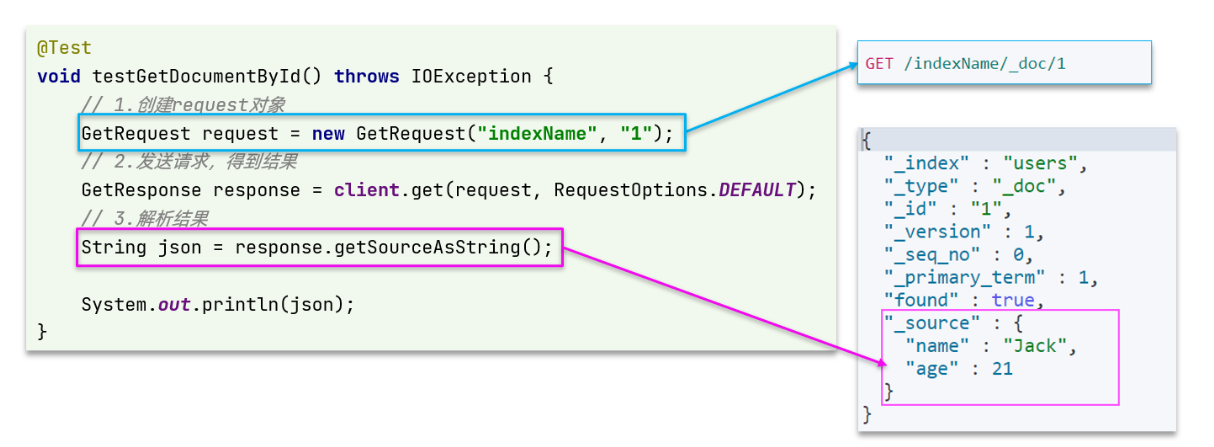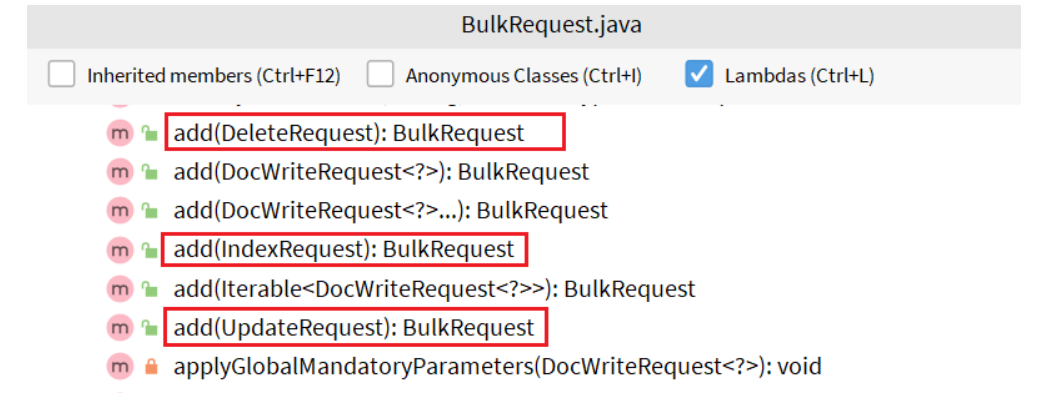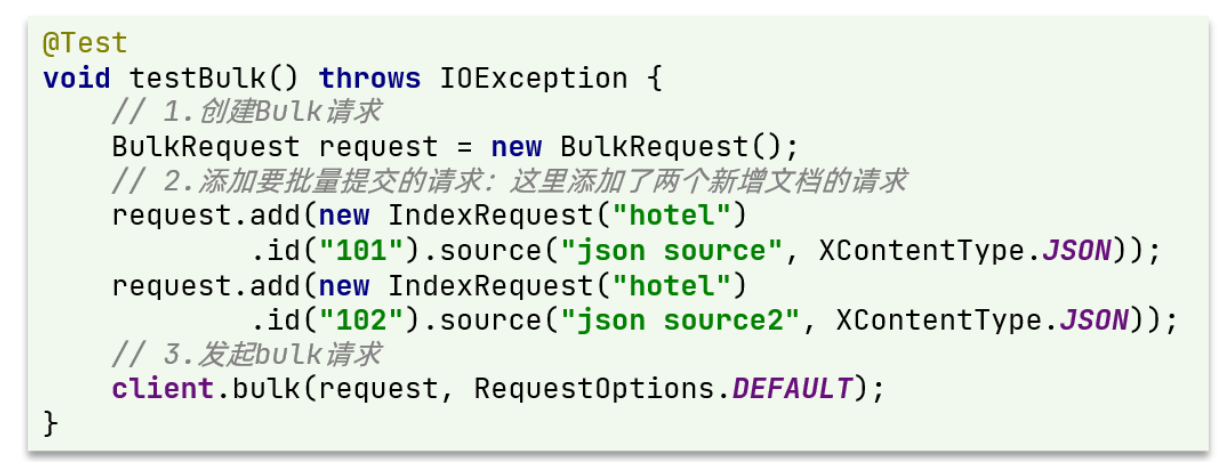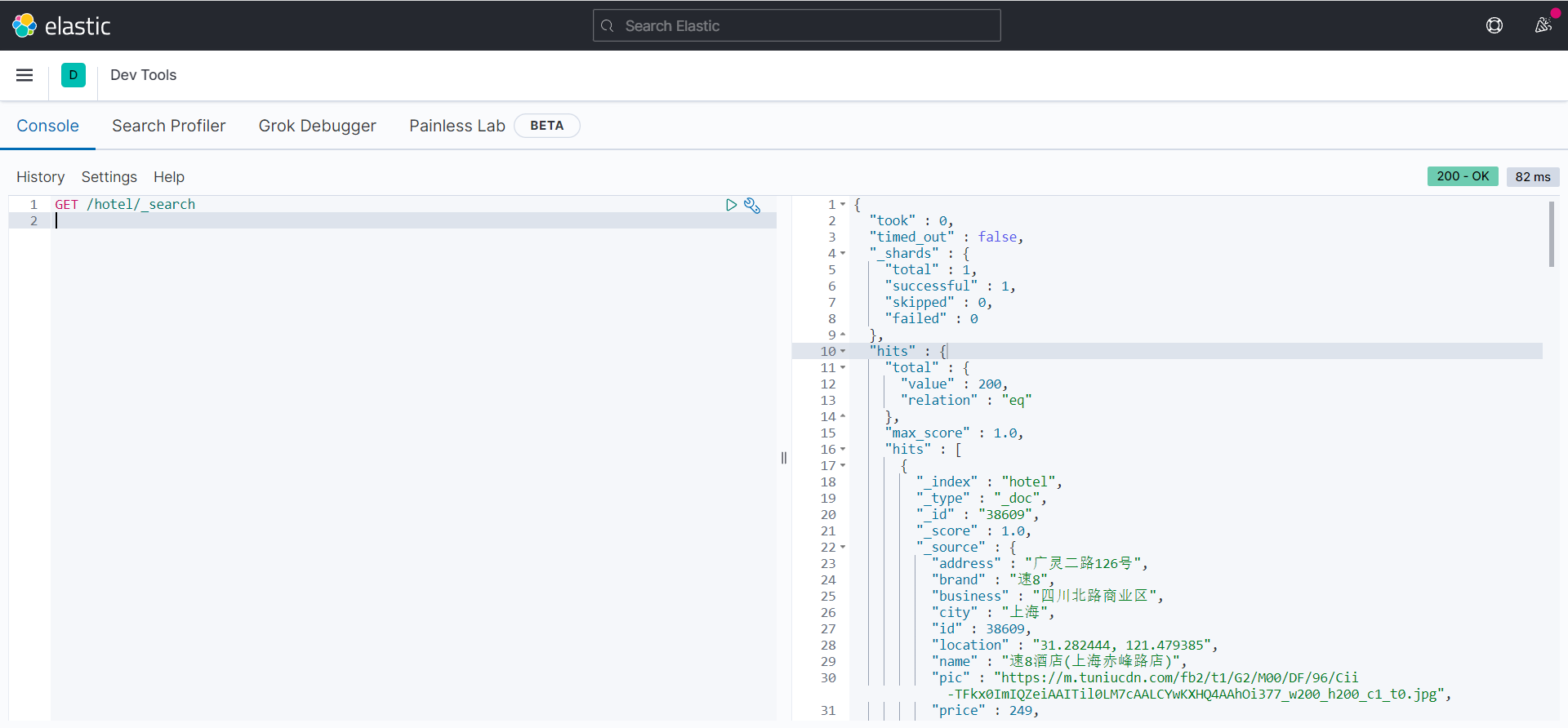- 数据结构——链表
- n皇后问题(DFS)
- 贪心算法(又叫贪婪算法)Greedy Algorithm
- 基于SpringBoot+vue的高校学生成绩管理系统
- Linux部署Sonarqube+Gogs+Jenkins(一)
- 已解决java.sql.SQLIntegrityConstraintV
- SpringBoot 缓存之 @Cacheable 详细介绍
- 【postgresql 基础入门】入门教程成形了,八大章节,涵盖库,表
- C++项目工程(包含opencv库以及项目的依赖库移植)编译成andr
- [架构之路-226]:信息系统建模 - 实体关系图、数据流图、数据字典
- 互联网加竞赛 大数据疫情分析及可视化系统
- Prometheus实战篇:Prometheus监控nginx
- SpringBoot 整合Swagger2
- Java实战:Spring Boot集成Swagger3
- visual studio配置node.js开发(完整版)
- [MySQL报错]关于发生net start mysql 服务无法启动
- Mysql中的Optimize table命令
- Ubuntu系统使用Docker本地部署Android模拟器并实现公网
- go包下载时报proxyconnect tcp: dial tcp 1
- 【工作记录】springboot应用实现license认证
- 【MySQL】MySQL用户管理
- 云计算时代的运维: 职业发展方向与岗位选择
- 已解决net.dean.jraw.http.NetworkExcept
- 惊艳的KMP字符串匹配算法
- IDEA实现ssh远程连接本地Linux服务器
- 2024四川省赛“信息安全管理与评估“--网络事件响应--应急响应(高
- Linux部署环境Nginx篇(安装Nginx1.24.0)
- The artifact mysql:mysql-connector-
- 【算法Hot100系列】旋转图像
- Spring Boot中多线程的使用
文章目录
- ⛄引言
- 一、初始化 Java RestClient
- 二、RestClient 对文档的CRUD操作
- ⛅新增文档
- ⏰查询文档
- ⚡修改文档
- ⌚删除文档
- 三、RestClient 批量文档导入
- ⛵小结
⛄引言
本文参考黑马 分布式Elastic search
Elasticsearch是一款非常强大的开源搜索引擎,具备非常多强大功能,可以帮助我们从海量数据中快速找到需要的内容
一、初始化 Java RestClient
初始化RestHighLevelClient
为了与索引库操作分离,我们再次参加一个测试类,做两件事情:
- 初始化RestHighLevelClient
- 我们的酒店数据在数据库,需要利用IHotelService去查询,所以注入这个接口
文档测试类
import com.alibaba.fastjson.JSON; import org.apache.http.HttpHost; import org.elasticsearch.action.admin.indices.delete.DeleteIndexRequest; import org.elasticsearch.action.bulk.BulkRequest; import org.elasticsearch.action.delete.DeleteRequest; import org.elasticsearch.action.get.GetRequest; import org.elasticsearch.action.get.GetResponse; import org.elasticsearch.action.index.IndexRequest; import org.elasticsearch.action.update.UpdateRequest; import org.elasticsearch.client.RequestOptions; import org.elasticsearch.client.RestClient; import org.elasticsearch.client.RestHighLevelClient; import org.elasticsearch.client.indices.CreateIndexRequest; import org.elasticsearch.client.indices.GetIndexRequest; import org.elasticsearch.common.xcontent.XContentType; import org.junit.jupiter.api.AfterEach; import org.junit.jupiter.api.BeforeEach; import org.junit.jupiter.api.Test; import org.springframework.beans.factory.annotation.Autowired; import org.springframework.boot.test.context.SpringBootTest; import java.io.IOException; import java.util.List; /** * @author whc * @date 2023/2/28 15:01 */ @SpringBootTest public class HotelDocumentTest { private RestHighLevelClient restHighLevelClient; @Autowired private IHotelService hotelService; @BeforeEach void setUp() { this.restHighLevelClient = new RestHighLevelClient(RestClient.builder( HttpHost.create("IP地址:9200") )); } @AfterEach void tearDown() throws IOException { this.restHighLevelClient.close(); } }测试类初始化 RestClient完毕。
二、RestClient 对文档的CRUD操作
下面我们通过RestClient 对 文档进行 增删改查操作,以便更加深层次的理解。
⛅新增文档
需求: 将酒店数据从数据库查询出来,通过RestClient写入到ElasticSearch中。
实体类与索引库实体类的转换
数据库返回的结果是一个Hotel类型的对象,属性如下:
@Data @TableName("tb_hotel") public class Hotel { @TableId(type = IdType.INPUT) private Long id; private String name; private String address; private Integer price; private Integer score; private String brand; private String city; private String starName; private String business; private String longitude; private String latitude; private String pic; }那么问题来了,我们的ElasticSearch 索引库的结构与实体类不一致该怎么办?
例如:经纬度,索引库中是 通过location来实现的,通过 , 分割开 。 实体类中则是两个单独的属性。
因此,我们需要定义一个新的对象,将该属性进行合并从而达到我们想要的结果
import lombok.Data; import lombok.NoArgsConstructor; @Data @NoArgsConstructor public class HotelDoc { private Long id; private String name; private String address; private Integer price; private Integer score; private String brand; private String city; private String starName; private String business; private String location; private String pic; public HotelDoc(Hotel hotel) { this.id = hotel.getId(); this.name = hotel.getName(); this.address = hotel.getAddress(); this.price = hotel.getPrice(); this.score = hotel.getScore(); this.brand = hotel.getBrand(); this.city = hotel.getCity(); this.starName = hotel.getStarName(); this.business = hotel.getBusiness(); this.location = hotel.getLatitude() + ", " + hotel.getLongitude(); this.pic = hotel.getPic(); } }语法说明
新增文档的DSL语句如下:
POST /{索引库名}/_doc/1 { "name": "Jack", "age": 20 }Java代码如下

可以看到与创建索引库类似,同样是三步走:
- 1.创建Request对象
- 2.准备请求参数,也就是DSL中的JSON文档
- 3.发送请求
变化的地方在于,这里直接使用**client.xxx()的API,不再需要client.indices()**了。
完整代码测试新增文档
@Test void testAddDocument() throws IOException { //获取酒店数据 Hotel hotel = hotelService.getById(36934L); HotelDoc hotelDoc = new HotelDoc(hotel); //1.创建request对象 IndexRequest request = new IndexRequest("hotel").id(hotel.getId().toString()); //2.准备参数 request.source(JSON.toJSONString(hotelDoc), XContentType.JSON); //3.发送请求 restHighLevelClient.index(request, RequestOptions.DEFAULT); }执行即可。
⏰查询文档
查询的DSL语句如下:
GET /索引库名/_doc/{id}大致分为2步
- 准备Request对象
- 发送请求
不过查询的目的是得到结果,解析为HotelDoc,因此难点是结果的解析。完整代码如下:

可以看到,结果是一个 JSON,其中文档放在一个_source属性中,因此解析就是拿到_source,反序列化为Java对象即可。
与之前类似,也是分为三步
- 1.准备Request对象。这次是查询,所以是GetRequest
- 2.发送请求,得到结果。因为是查询,这里调用client.get()方法
- 3.解析结果,就是对JSON做反序列化
完整代码
@Test void testGetDocument() throws IOException { //1.创建request对象 GetRequest request = new GetRequest("hotel", "36934"); //2.发送请求 GetResponse response = restHighLevelClient.get(request, RequestOptions.DEFAULT); String sourceAsString = response.getSourceAsString(); System.out.println(sourceAsString); }结果如下:

⚡修改文档
修改是分为两种方式:
- 全量修改:本质是先根据id删除,再新增
- 增量修改:修改文档中的指定字段值
在RestClient的API中,全量修改与新增的API完全一致,判断依据是ID:
- 如果新增时,ID已经存在,则修改
- 如果新增时,ID不存在,则新增
这里我们主要介绍 增量修改
代码示例如下:

与之前类似,主要分为三步
- 1.准备Request对象。这次是修改,所以是 UpdateRequest
- 2.准备参数。也就是JSON文档,里面包含要修改的字段
- 3.更新文档。这里调用client.update()方法
完整代码
@Test void testUpdateDocument() throws IOException { //1.创建request对象 UpdateRequest request = new UpdateRequest("hotel", "36934"); //2.准备参数 request.doc( "price", "456", "starName", "三钻" ); //3.发送请求 restHighLevelClient.update(request, RequestOptions.DEFAULT); }修改结果
执行完毕修改后,再次通过get请求查看修改结果

⌚删除文档
删除的DSL为是这样的:
DELETE /hotel/_doc/{id}与查询相比,仅仅是请求方式从DELETE变成GET,可以想象Java代码应该依然分为三步:
- 1.准备Request对象,因为是删除,这次是DeleteRequest对象。要指定索引库名和id
- 2.准备参数,无参
- 3.发送请求。因为是删除,所以是client.delete()方法
完整Java代码
@Test void testDeleteDocument() throws IOException { //1.创建request对象 DeleteRequest request = new DeleteRequest("hotel", "36934"); //2.发送请求 restHighLevelClient.delete(request, RequestOptions.DEFAULT); }查看删除结果
执行完毕后,调用get请求查看结果

三、RestClient 批量文档导入
需求:利用BulkRequest批量将数据库数据导入到索引库中。
步骤如下:
- 利用 mybatis-plus 查询酒店数据
- 将查询到的酒店数据(Hotel)转换为文档类型数据(HotelDoc)
- 利用JavaRestClient中的BulkRequest批处理,实现批量新增文档
批量处理BulkRequest,其本质就是将多个普通的CRUD请求组合在一起发送。
其中提供了一个add方法,用来添加其他请求

可以看到,能添加的请求包括:
- IndexRequest,也就是新增
- UpdateRequest,也就是修改
- DeleteRequest,也就是删除
因此Bulk中添加了多个IndexRequest,就是批量新增功能了。示例:

依旧是分为三步:
- 1.创建Request对象。这里是BulkRequest
- 2.准备参数。批处理的参数,就是其它Request对象,这里就是多个IndexRequest
- 3.发起请求。这里是批处理,调用的方法为client.bulk()方法
导入酒店数据后,将代码改为for循环即可
完整Java代码
@Test void testBulk() throws IOException { //获取酒店数据 Listhotels = hotelService.list(); //1.创建bulk请求 BulkRequest request = new BulkRequest(); //2.添加批量处理的请求 for (Hotel hotel : hotels) { HotelDoc hotelDoc = new HotelDoc(hotel); request.add(new IndexRequest("hotel"). id(hotel.getId().toString()).source(JSON.toJSONString(hotelDoc), XContentType.JSON)); } //3.发送请求 restHighLevelClient.bulk(request, RequestOptions.DEFAULT); } 查看执行结果
执行完毕后,执行 以下DSL语句批量查询

执行完毕,导入成功。
⛵小结
以上就是【Bug 终结者】对 微服务分布式搜索引擎 Elastic Search RestClient 操作文档 的简单介绍,ES搜索引擎无疑是最优秀的分布式搜索引擎,使用它,可大大提高项目的灵活、高效性! 技术改变世界!!!
如果这篇【文章】有帮助到你,希望可以给【Bug 终结者】点个赞👍,创作不易,如果有对【后端技术】、【前端领域】感兴趣的小可爱,也欢迎关注❤️❤️❤️ 【Bug 终结者】❤️❤️❤️,我将会给你带来巨大的【收获与惊喜】💝💝💝!
上一篇:vue项目中使用scss














